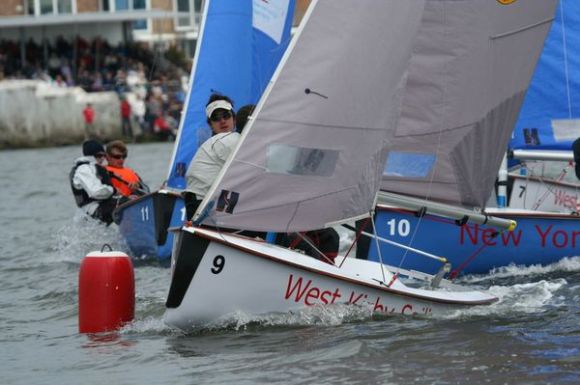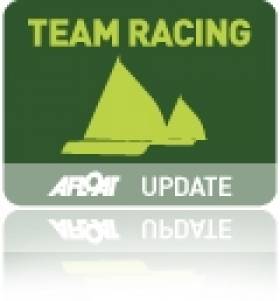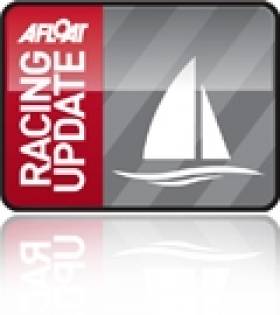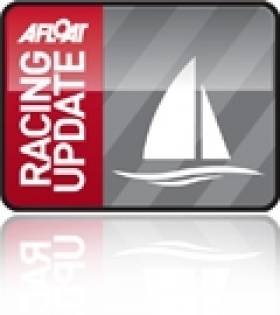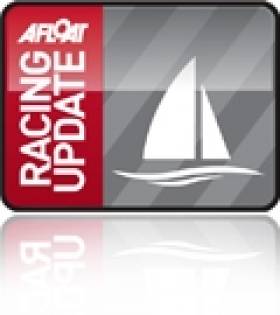Displaying items by tag: Team Racing
Selection Procedure for Team Racing Worlds Underway
The selection procedure to designate the teams to represent Ireland at the ISAF Team Racing Worlds is underway.
Teams wishing to be considered for selection should contact the Irish Team Racing Association a [email protected]. A selection committee will then invite teams to trials to be sailed early in 2011. Invitations will be issued on the basis of the results of all team members (helm and crew) in 2009 -2010.
The trials will consist of a multiple round robin event. The Youth trials will be sailed in Crosshaven, and the senior trials in Dun Laoghaire. Unfortunately, the number of places available for Ireland at the World Championships is not yet known, but ITRA will select two senior teams, plus a reserve team, and two Youth teams, plus a reserve.
Spinnaker on Top in Team Racing National Championships
Last weekend's The Irish Team Racing Association National Team Racing Championships attracted it's largest entry for many years, with 21 teams registered.
The event was hosted by the Fastnet Marine and Outdoor Education Centre in Schull, West Cork.
Four teams travelled over from the UK, and 6 under 19 teams, all from County Cork, competed. They joined the keenest of the post-college teams and the leading university teams to constitute the largest Championships that Ireland has seen for many years. Schull, the venue for next year's World Championship, was a major attraction, but the change of date, from March to November, has made it easier for college students and school pupils to attend.

Weekend Team Racing action from Schull. More photos HERE. Photos: Brian Carlin
The weather forecasts had been predicting storms, floods and general mayhem for days if not weeks beforehand. But Saturday dawned to reveal Schull Harbour in an unusual state – the wind had disappeared! Racing started 3 hours later than planned. However, by the end of the day the first round had been completed. This was a seeded round robin, with each of the four League made up of a UK team, a leading Irish team, a leading college team and two others, including the youth teams.
The results of the first round determined entry into the second round – all the UK teams won all four leagues, with the George Knights, the George Gladiators, Supertroopers and UCD finishing second. These teams were joined in the Gold Leagues of the second round by the winners of play-offs between third place teams. The Bumsby Babes, a youth team from Royal Cork YC, had done well to win 2 races to qualify for a play-off against University of Limerick and they were in a strong position when equipment failure meant that one of their boats retired . In the subsequent re-sail UL managed to win the race and qualify.
On Sunday morning Schull was looking it's best in bright but cold sunshine. Unfortunately, the beauties of the West Cork landscape were exactly mirrored in the unruffled water of the harbour! Competitors, who had made a remarkable effort to arrive on time for an 0900 start, barely recovered from the reception organised the previous evening by the World Championship Committee, waited. When racing eventually got underway, in a fitful breeze, it quickly became obvious that there was no possibility of finishing the second round. Plan B was implemented, a knockout round between the four winners of Round One to determine the outright winner, another between the 4 Irish team placed second in the Round One Leagues to determine the ISA medal places and a Youth round.
GP14 World Champion Ian Dobson in Schull
Spinnaker came through the semis and final to win overall first place. The two Royal St George teams qualified for the final. Last year's winners, the Gladiators won the first race only after finishing places were confirmed by a redress hearing. However, the more experienced Knights went on to win the next to races to reclaim the trophy they had "lent" to the Gladiators last year. The third place play-off, which saw some of the noisiest races of the weekend, resulted in a win by Supertroopers over UCD.
In the Youth event Schull A beat Schull B to win the opportunity to take on, and eventually defeat the Bumsby Babes.
Next year's Championship will be sailed out of the Royal St. George on 12-13 November. However the next challenge for Irish team racers will be qualification for the World Championship, with selection trials planned for both the Youth and Open categories early in 2011.
The event was also the first opportunity to try the new TR3.6 which will be used for the Team Racing Worlds. Video below of the new TR3.6 and voice over from Team Racing World organiser David Harte in Schull. Stills by Brian Carlin HERE.
Royal St George Win Cumberland Cup
With a close to perfect score, Andrew Fowler's team of Sam Hurst, Brendan Fafliani, John Sheehy, Nick Smyth, Guy O'Leary, Peter Bailey and Phil Lawton from Royal St George YC in Dublin, won the 2010 Royal Thames Cumberland Cup from Ian Ilsley's team from Yacht Club de Monaco writes Malcolm McKeag. Firm friend and arch-rival of the home side the Southern Yacht Club of New Orleans was third, claiming by dint of that result the Bourgne Cup, contested on each and every occasion the clubs meet, in whatever larger competition..
Over three days at Queen Mary Water hard by Heathrow airport the seven teams sailed a total of 54 races in the international yacht club contest, ferried to and fro from the RTYC's Knightsbridge clubhouse in that iconic symbol of London, a bright scarlet Routemaster double-decker omnibus.
Sailing in a fleet of eight carefully-matched modified J80s the competition began with a two-day double round-robin in which each team raced each other team twice. St George topped the league, winning 11 out of their 12 matches and losing only to the hosts and current holders, Royal Thames, and thus apparently setting the scene for the finals. It was a scene dramatically re-shaped by the winner-take-all nature of the Cumberland Cup's competition structure.
With teams travelling from across the globe to compete in this regatta, the organisers deliberately eschew a competition format that eliminates teams early from the competition, espousing instead a format that keeps every team sailing into the final round. The result is The Ladder, which as some teams including the hosts found to their cost might be better termed The Greasy Pole. On The Ladder, a win carries the double bonus of promotion to the next rung – but every loss earns the double-penalty of relegation. On The Ladder, it is just possible by dint of really good sailing to redeem a disappointing result in the round-robin and climb all the way to the top – as did the Monegasques – while the series leaders – in this case the Irish – must not put a foot wrong if they are to retain their fingertip grip on the crown.
Thus on Sunday The Ladder's first and lowest rung saw the Germans face-off against the Kiwis for a chance for stardom, while Royal St George had to wait patiently to see which of the Yanks (and it's not often the team from New Orleans are called Yankees!) and the Brits would be first to step up to try and knock them off their perch. As matters transpired, it was Royal Thames who beat the Southerners to race against the champs: to no avail. Royal St George won.
After Round One, the Brits began what turned out to be their slide down The Ladder, while the visitors from the Mediterranean climbed ever higher. The Southern, meanwhile, had to dispose of Royal Port Nicholson if they were to have a chance, in Round Three and the final round of The Ladder, of another crack at the leaders.
With Port Nich out of the way, the crunch race in Round Three was that between the Southern – highly vocal as always – and Monaco, who had quietly beaten Royal Thames when Ben Clothier of the host club earned a penalty for inadvertently but illegally 'sculling' the boat with the rudder while trying to slow down to block his rival. Given that in the round-robin YCdeM had lost almost as many races as they had won (and then been penalised a further point for a violent T-bone collision in their early race against St George) it is not unkind to suggest that their presence, by Round Three, on the top rung of The Ladder had been predicted by few. But Ian Ilsley, their team captain who by his own admission 'hadn't team raced for years' had by now earned both the respect of his rivals and the nickname 'the Old Fox'.
Southern, in blue jackets, began by blowing the yellows away at the start to be a comfortable and apparently safe 1-2 at the windward end of the course – but somehow one of the YCM team managed to get close enough on the long run to engage a blue boat and suddenly it was Game On again. On the final beat all four boats were mixed together and the denouement came – as so often in this two-boat team racing where the crucial factor is that the team with the boat in last place loses the match – at, beyond, above and back round again to the finishing line, with a Southern boat blocking out one Monaco boat only to find his own way back blocked by the other Monaco boat. And vice versa. Finally a Southern boat crossed the finish line – only to cop a penalty by blocking the path of the last returning Monaco boat under the rule that says a boat no longer racing must not interfere with one that is still racing.
And so it was a Monaco-Ireland final. If anyone thought this would be a walk-over for the Irish, they were wrong. Monaco had their tails up and no mistake. Once again it was their down-wind sailing that kept them engaged and it was not until the final mark, when the Monaco boat in second earned a penalty, that it really was Game Over.
Monaco were justly pleased with their Ladder climb from 4th place after the Round Robin – but none could nay-say the Irish for their win. 15 matches sailed and only one of them lost.
Photos below and on our gallery by Ingrid Abery





More photos here on our gallery.
Irish team take Cumberand Cup
A Royal St George YC team have taken the prestigious Cumberland Cup over the weekend after a near-flawless series of racing. The team went into the final stages without dropping a single race, and claimed what's thought to be the oldest trophy in sailing for Ireland. The event was sailed in J80s on Queen Mary SC's reservoir, starting on Friday after a royal reception in St James' Palace on Thursday night.
Royal Thames YC has yet to provide any details on the week's racing but we'll have more from the team later in the day. More here now.
RSGYC take on Cumberland Cup
A Royal St George YC team will be the sole Irish representatives at the Royal Thames YC Cumberland Cup, the oldest perpetual trophy in yacht racing, with racing kicking off today at Queen Mary SC. The event is a two-boat team racing event sailed in J80s with the home team, Royal Thames, the current holders. The RSGYC team, headed up by John Sheehy and Nick Smyth, will face off against teams from Australia, Monaco, Germany, Australia, New Zealand and the USA. The Cumberland Cup dates back to 1775 and was established some 76 years before the America’s Cup
Two-boat team racing is best known in Ireland through the 'random pairs' format, where the team with a boat in last place loses the race. The result is highly tactical and combative, aggressive sailing, with the final beat to the finish line becoming particularly frantic.
Sheehy and Smyth come off a weekend that saw the pair finish in the last eight at the presitigous Wilson Team Racing Trophy in West Kirby SC, and Sheehy is also Ireland's top-ranked match racer at present.
Racing kicks off this morning, and you can catch some glimps of the action on the reservoir on their website's live webcam.
Two RSGYC teams in Wilson last eight
Two teams from the Royal St., George YC in Dun Laoghaire made it to the last eight of the 339-race Wilson trophy after 20 rounds of competition at West Kirby Sailing Club this weekend. It is the 16th appearance for the club at the UK event. Both the George Knights, (John Sheehy/Noeline Morgan, Nick Smyth/Rach Macmanus and Ger Owens/Melanie Morris) and another Royal St George team (Marty O'Leary/Brian Fenlon, Sam/Rachel O'Brien and Jonny O'Dowd/Rachel Guy) reached the quarter-final stage and pushed their quarters to the third race of the best-of-three, but failed to progress.
The final day of the 2010 Wilson Trophy dawned beautifully bright and clear and following a brief delay to allow the wind to build strength and stabilise direction, racing for the final part of the round robin element got underway. At this stage in the competition, every point counted for those teams hoping to make into the final eight and with a gaggle of teams mathematically capable of progressing to the next round, many of the matches understandably developed into full pitched battles.
American visitors Team Extreme continued where they had left off from the previous two days and immediately began adding to their string of winning performances to further extended their advantage at the top of the leaderboard. By midday the both local West Kirby Hawks and the American Woonsocket Rockets had also guaranteed their places in the quarterfinals. Despite showing much promise in the previous two days, the team from Royal Thames suffered a disastrous sequence of defeats in the early morning races, which plummeted them down the pecking order and effectively snuffed out their chances of qualifying for the knockout rounds. Meanwhile both Bath and the local Hibre Highlanders team were staging last-ditch bids to make the final eight with stellar performances in their races. When these two teams eventually met, it was the Hilbre Highlanders who managed the last beat to perfection to cross the line in a convincing 1,2,4 configuration and keep their hopes of a quarter-final berth alive.
The final round of races threw up a series of do or die confrontations. In the match between the Royal St George and New York Red the American team saw off a frenzied attack by the Irish on the final beat to take the win with a 2,3,4 pattern at the finish. Wessex Exempt needed to win their race against Hilbre Highlanders to qualify for the knockout stage. With almost nothing between the two teams for the first two legs, the final run developed into a six-way dogfight, which also continued down the penultimate leg, and if anything the action intensified even further on the final beat. With advantage flick-flacking between the two teams as the boats approached the line, the Highlanders looked to have done enough, but a penalty against them in the last few seconds saw Wessex Exempt snatch the win and squeak their way through to the final rounds. The New York Red versus West Kirby Sailing Club match was an important affair for both teams. After a truly classic battle, the local team grabbed the advantage on the final mark rounding to take a winning 2,3,4 combination which they held comfortably to the finish.
The quarterfinals turned out to be a real showcase for top-flight team racing, with all the matches requiring three races to separate the teams. Wessex Exempt took the round robin winners Team Extreme to the wire but finally succumbed to a commanding performance from the Americans in the final race. The match between the reigning champions West Kirby Hawks and the Royal St George was a real nail biter and only decided in the final boat lengths to the finish of the third race. West Kirby Hawks made a remarkable comeback on the final beat to eke out a 2,3,5 victory in a photo finish on the line. A last beat penalty against the St George Knights whilst approaching the finish of their third race against New York Red put paid to the Knights challenge and left the New York Red team to join their countrymen in the semi final. After losing their first race against the Woonsocket Rockets the West Kirby Sailing Club team looked to be facing elimination when they trailed the American team at the final mark of their second race. However a masterful piece of team racing at on the final beat saw them claw their way back to a winning 1,3,5 overturn at the finish.
The semi-final pairings threw up both all American and all West Kirby matches. Team Extreme won the first race of the American semi-final and took early control of the second race with a great team start. Their advantage was increased when a penalty was awarded against the race leading New York Red boat for an illegal mark trap attempt at the first buoy. New York Red never really recovered from this and Team Extreme were able to close out the match two wins to nil.
West Kirby Hawks also won their tense local derby match against West Kirby Sailing Club two races to zero. West Kirby Sailing Club didn’t go down without a fight however and turned the second race into the team racing equivalent of a western bar room brawl. With all six boats locked in a melee of team racing manoeuvres for the entire race, advantage swung backwards and forwards on each leg, but the West Kirby Hawks eventually prevailed on the final beat to take their second win of the semi-final and secure their place in the Grand Final.
Team Extreme looked to have handed the first race to the West Kirby Hawks when two of their boats were caught OCS on the start. However by the first mark the Americans were right back in it and pushing for a winning combination on the first reach. A double mark trap by the West Kirby Hawks appeared to have put the local team back in control but in the scrap on the penultimate leg the Hawks were awarded two penalties which gave Team Extreme a 1,2,3 winning score at the finish.
Race two of the Grand Final got off to an even start with Team Extreme eking out a narrow 2,3,4 advantage by the top mark. The visitors held both their nerve and their winning positions on the following three legs and despite some slick race-slowing attempts by the leading West Kirby Hawks boat, the Americans were still in control at the start of the final beat. Team Extreme very effectively locked down the race on the last leg, narrowing the local team’s options and eventually taking their second win to go two nil up in the Grand Final.
Race three got away with a closely fought start which saw a single West Kirby Hawks boat called OCS. The action remained too close to call for the entire first beat but when Team Extreme were awarded a penalty on the approach to the top mark, the West Kirby Hawks were able to get around in a useful 2,3,5 combination. However, a West Kirby Hawks penalty at the end of the first reach quickly threw the advantage back to Team Extreme. The Americans immediately capitalised on this with a neat mark trap at the bottom of the run, catapulting them into a powerful 1,2,5 combination. The West Kirby Hawks woes were then further compounded by yet another penalty at the final mark and this left them powerless to prevent Team Extreme easing into a game, set and match winning 1,2,3 formation at the finish.
So Team Extreme from the USA, - Zach Brown & Emmet Smith, Adam & Melanie Roberts and Stuart McNay & Abby Coplin - who had dominated the qualification rounds so comprehensively, had gone on to pull off an equally dominant whitewash victory in the Grand Final and become deserved winners of the 2010 Wilson Trophy British Open Team Racing Championship.
Full results at the end of day one can be found at the official website: http://www.wksc.net/
Photos by Phil Shepherd
